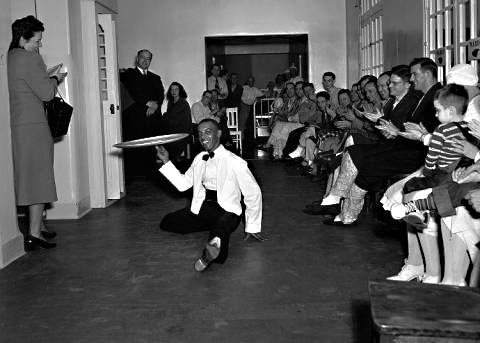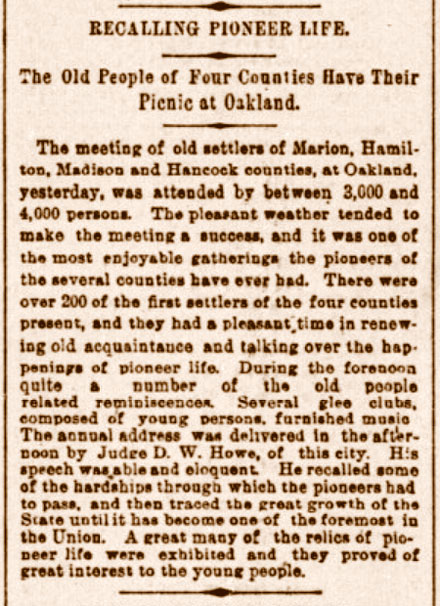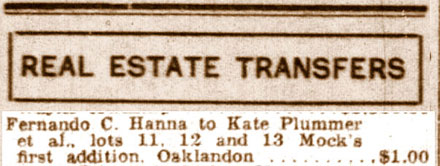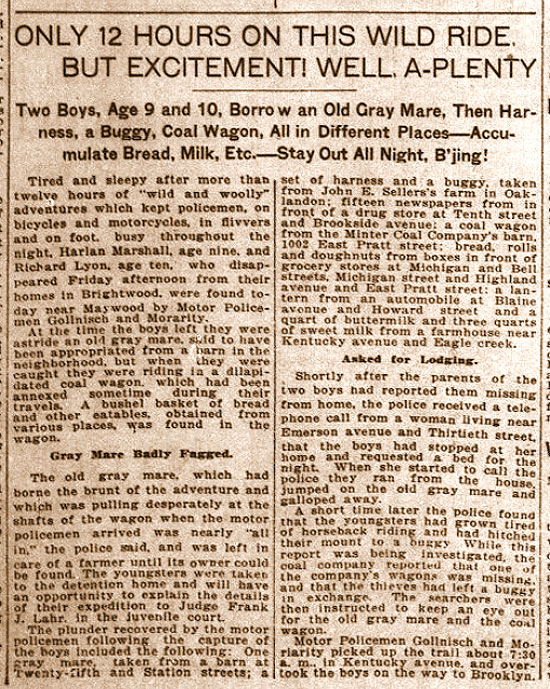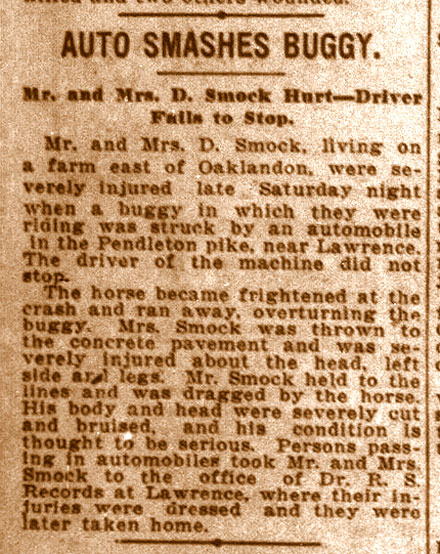User Functions
What's New
Stories last 24 hours
No new storiesComments last 2 days
No new commentsTrackbacks last 2 days
No new trackback commentsLinks last 2 weeks
No recent new linksMedia Gallery last 7 days
No new media itemsWelcome to Oaklandon Thursday, April 25 2024 @ 07:41 am EDT
The Dancing Waiter at Sanitorium

- Friday, December 14 2018 @ 04:01 pm EST
-
- Contributed by:
- Mike
-
- Views:
- 7,944
George Gibson, "the Dancing Waiter" entertains patients at the Sunnyside Tuberculosis Sanitorium, also called the Marion County Tuberculosis Hospital. The sanitorium was located on Route 12 (now 36) northeast of Indianapolis in an area called Oaklandon. Though tuberculosis had previously been treatable only through surgery, the antibiotic streptomycin became available in 1946. Gibson performed in the United States and Europe for decades, and appeared on the Ed Sullivan Show, the Milton Berle Show, and more.
Source: Larry Foster Collection | Indiana Historical Society [03/15/1948]
Highest Resolution Archive Image
- Comments (0)
- Trackbacks (0)
Carpenter Realty on Oaklandon

- Thursday, December 13 2018 @ 02:13 pm EST
-
- Contributed by:
- Mike
-
- Views:
- 1,737
 From CallCarpenter.com
From CallCarpenter.com
At the northeastern edge of Marion County, just a few miles past Lawrence and just a step from McCordsville and Hancock County, you’ll find the small community of Oaklandon.
Back in 1849, the now-deceased John Emery laid out a small village northeast of the state capitol. Originally called Oakland, it was changed to Oaklandon around 1870 when they got their post office … and the first "Oakland” in Indiana objected to a second "Oakland.” So we add an "on” and we’re set to go.
In the early years, the town fostered a sense of community, with strong churches, lodges and local businesses. There was plenty of space to stretch out, yet it was close-knit. Throughout the late 19th and early 20th centuries, there are stories of town bands that were very well-known, playing in their own Oklandon bandstands and other area events, even the Indy 500.
By the 1920s, Oaklandon was beginning to be more suburb than town. Never incorporated as a true town or city, the new State Road 67 (built past, not through Oaklandon) made commuting to Indianapolis an easy task. An interurban line took that a step further.
Interesting story (directly quoted from A History of Oaklandon, The Lawrence Chamber of Commerce): A 1927 feature story in The Indianapolis News explains why there were no saloons in Oaklandon. About 1887, the women of Oaklandon apparently organized a branch of the Women's Christian Temperance Union, an organization that included a campaign against alcohol. Their target was the lone saloon in Oaklandon.
Adeline Apple, 83, was interviewed. The feature story said, "Mrs. Apple, with a twinkle in her eye, tells how she and the other women went into the saloon unannounced one night and sat down, much to the consternation of the men who soon took to their heels.
The second night, she said, the saloonkeeper had hoped to prevent their staying by having all the chairs taken out. The women, undaunted, stood around the stove. "The nightly visitations of the feminine contingent destroyed business and the saloon soon disappeared according to Mrs. Apple,"
We’re thinking the business disappeared, not the actual building. But we weren’t there, so …
After the second World War, Lawrence and Oaklandon found themselves even more a suburb of Indianapolis. Lawrence, a city, started actions to annex Oaklandon. Oaklandon objected, sued, fought and got all riled up, but Lawrence finally won out in 1976.
Today, the Oaklandon community maintains an identity, with a bright "Oaklandon” water tower, its original Oaklandon Road and a few small monuments celebrating the one-time village, now suburb.
- Comments (0)
- Trackbacks (0)
OAKLANDON CELEBRATES 150

- Thursday, December 13 2018 @ 01:46 pm EST
-
- Contributed by:
- Mike
-
- Views:
- 2,358
I found the following on an Archive.org "Wayback Machine" 2006 snapshot of
LawrenceChamberOfCommerce.com
OAKLANDON CELEBRATES 150
Community takes different direction
Oaklandon was platted just months after Lawrence, but the community took a different direction, possibly due to its location, an additional 4 miles from Indianapolis.
John Emery platted the village first called Oakland, a named suggested by a man identified only as "Dr. Moore," according to Indianapolis and Marion County Historian B.R. Sulgrove.
As in Lawrence, it was the post office that led to the final naming of the community. Oaklandon Historian Steven Hamilton noted that when the post office was moved from Germantown to Oakland in 1870, the name Oaklandon was selected. Eventually, the mail address determined the community's name.
Sulgrove painted an unflattering portrait of the community in his 1884 volume. He wrote that "the streets have never been improved and many of the houses are in a dilapidated condition, and the village presents the appearance of age and decay."
Paul Hamilton replied to Sulgrove's assessment in a history of Oaklandon published in 1972. Hamilton wrote, "Even though the historian B,R.S, (Sulgrove) referred to the dilapidated condition of many houses in 1884, some senior citizens of today recall that there were many attractive houses and home sites in Oaklandon during their growing up years,"
Had Sulgrove spent time in the community and met some of the residents, he might have gained a very different perspective.
Accounts of Oaklandon highlight strong churches and fraternal organizations, its doctors, the bankers, the undertaker and the proprietors of the various general stores. Even the undertaker is remembered.
For its small size, Paul Hamilton reported, the village was scarcely without a town band, orchestra or both in the years leading to school-sponsored music organizations. A bandstand - two stories high - was located prior to 1916 at the site of the Oaklandon State Bank, at 63rd Street and Oaklandon Road.
A second ground level, open bandstand stood until the late 1920s further south on Oaklandon Road.
Lifelong resident Victor Harris noted that Oaklandon contributed mightily to an area wide Odd Fellows Lodge band that used to play annually at the Indianapolis 500 Mile Race.
A description of the community from the 1914 Oaklandon High School annual had this to say: "The village contains a few streets and about 75 houses. An excellent feature of the town is that no one is crowded for room. Every family has plenty of room for gardens and truck patches. The town affords three large lodge halls and more stores in general than are needed, yet they furnish plenty of good loafing places for a number of Oaklandon citizens. Besides these, there are four barbershops, a livery barn, a bakery and two general repair shops. Unfortunately, the town possesses neither saloons nor gambling rooms. However, in nice weather some of the most prominent men convene on the south bank of the railroad behind a large signboard to have a nice quiet game of poker. When they need something to quench their thirst, they can board an interurban car at any hour during the day bound for the city."
A 1927 feature story in The Indianapolis News explains why there were no saloons in Oaklandon. About 1887, the women of Oaklandon apparently organized a branch of the Women's Christian Temperance Union, an organization that included a campaign against alcohol. Their target was the lone saloon in Oaklandon.
Adeline Apple, 83, was interviewed. The feature story said, "Mrs. Apple, with a twinkle in her eye, tells how she and the other women went into the saloon unannounced one night and sat down, much to the consternation of the men who soon took to their heels. The second night, she said, the saloonkeeper had hoped to prevent their staying by having all the chairs taken out. The women, undaunted, stood around the stove.
"The nightly visitations of the feminine contingent destroyed business and the saloon soon disappeared according to Mrs. Apple."
The feature story further described the community: "Oaklandon has no industry and no motion picture show. But it has two churches, two groceries, a garage, a funeral director, a bank, an elevator, a feed store, and a restaurant. Barbershop and two filling stations in the town. There are four additional filling stations on Road 67 (Pendleton Pike) that sidestepped Oaklandon when it graduated into the three-lane class."
"Two new houses are being built by residents, who hope to rent the property they will leave. Houses are scarce, and some of the Army officers recently transferred to Fort Benjamin Harrison have rented stone or log cabins at the Paradise tourist camp, just north of town, on the main road."
"Unemployment is at a minimum, also thanks to the war. For many residents of Oaklandon arc employed at the Allison division of General Motors Corp., and the International Harvester Co. in Indianapolis, or at Delco-Remy and Guide Lamp at Anderson."
Referring to the interurban line, as well as Road 67 leading straight to Indianapolis or Anderson, the feature story ended, "Commuting is easy."
The News also describes a blackboard on a wall of the Oaklandon State Bank - the only bank for many years in Lawrence Township -, which "served as a classified advertising medium at no cost to anyone."
Ads on the blackboard included:
• Wanted - Young girl for housework. Mrs. Cooley. Wayside Gardens.
• Fresh Guernsey cow. Five years old, Good flow milk. Ed Brooks.
• Four-burner gas stove. Edna Glossbrenner.
Unlike Lawrence, Oaklandon never aspired to be an incorporated town. There was never a town board or a police marshal. The community formed a volunteer fire department only after names destroyed several important buildings, including the Universalist Church, the livery stable, the Red Men's Hall, McCord's Restaurant and a confectionary.
While fund raising for the volunteer fire department was a never-ending endeavor, Paul Hamilton reported contributions of time, money and materials resulted in a sidewalk along Oaklandon Road in 1910, shortly after the high school was constructed. "It provided a fine walkway for thousands of schoolchildren's feet and a base for hundreds of miles of roller-skating,'" he wrote.
Maintenance of the Pendleton Road - today called Pendleton Pike - was often a bother in Oaklandon's young days. Hamilton reported that when directors of the Indianapolis and Oakland Gravel Road Co. met in December 1872, they reported an income of $54 from the tollgate located on the southwest corner of the intersection of Pendleton Pike and Oaklandon Road. Hamilton said this about the 1920s paving efforts: "The Oaklandon community certainly deserved a good break sometime from the highway builders because the community suffered greatly from the paving of Road 67.
"Before paving, the road rounded the corner in front of the Legion Hall and then turned back northeast at the Oaklandon Telephone Building. Somehow, the engineers did not properly plain the drainage, and then the state and county road men never corrected the matter; and the present 'Canal Street' resulted."
Today, that street is known as Broadway.
The first interurban service to Indianapolis came in 1900 from the Union Traction Co. Later, the Indiana Railroad Co. ran it until the last car was run in January 1941, according to Hamilton. He said, "When one speaks of the last car, senior citizens are apt to think that means the one leaving Indianapolis Interurban Station at 11:30 p.m. and arriving at Oaklandon at 12: 14 a.m. Can't you hear the trainmaster calling: Lawrence, Oaklandon, McCordsville, Fortville, Ingalls... with Oaklandon having the accent on 'land' and not 'Oak' as the bus men later did it?"
Residents of Oaklandon never wanted to be part of Indianapolis, let alone Lawrence. When Lawrence initiated annexation proceedings about 1968, Oaklandon residents objected. After many years in court, Oaklandon became part of Lawrence in 1976. The Indianapolis Star reported nearly half of Oaklandon and Indian Lake residents would have rather been part of Indianapolis. Another story quoted Oaklandon residents as vowing to seek disannexation, but the action has stood.
Lawrence has allowed Oaklandon to maintain its identity. The water tower with the name Oaklandon rises out of Play Park, erupting in bright colors like a hot-air balloon. At the northwest corner of Oaklandon Road and Pendleton Pike is a brick monument honoring in its inscription all the village desired to be: Oaklandon Community.
- Comments (0)
- Trackbacks (0)
Excerpt: History of Indianapolis and Marion County

- Thursday, December 13 2018 @ 10:56 am EST
-
- Contributed by:
- Mike
-
- Views:
- 2,168
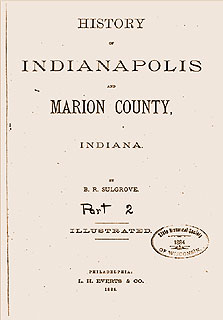 History of Indianapolis and Marion County, Indiana,
History of Indianapolis and Marion County, Indiana,Part 2
By Berry Robinson Sulgrove
L.H. Everts & Company, 1884 - Indianapolis
A detailed history of Indianapolis and Marion County, Indiana, from its settlement in the early 19th century. Covers general history, political history, business and industrial interests, social history, architecture and the history of each township within Marion County.
The following is an excerpt giving an overview of Oakland in 1884:
The village of Oakland is situated thirteen miles from Indianapolis, on the Bee-Line Railroad. It was laid out June 18. 1849, by John Emery. The name Oakland was suggeted by Dr. Moore. The streets have never been improved and many of the houses are in a dilapidated condition, and the village presents the appearance of age and decay. Subsequent to 1849 John Mock, Andrew F. Cory, John W. Combs, and Enoch Hanna laid out additions. The first merchants were the firm of John W. & William Combs; the first practicing physician was James W. Hervey. The town has a population of about two hundred, and has a telephonic connection and a Western Union Telegraph office. The railroad company recently completed a commodious depot, which adds greatly to the comfort of the traveling public. The present merchants are David G. Hanna and Naaman C. Plummer, both of whom are dealers in general merchandise. Andrew F. Cory and Jeff. K. Heltman are the physicians, and Naaman C. Plummer is the postmaster. The name of the postoffce is Oaklandon. The town has three churches, —a Methodist, a Christian, and a Universalist. The last two named have a large membership and are well attended. The first named, however, is in a precarious condition. The village contains a graded school, and the Masons, Odd-Fellows, and Grangers have lodges located there.
- Comments (0)
- Trackbacks (0)
Old Times

- Friday, December 07 2018 @ 03:11 pm EST
-
- Contributed by:
- Mike
-
- Views:
- 2,614
Indianapolis, Marion County, 3 August 1878
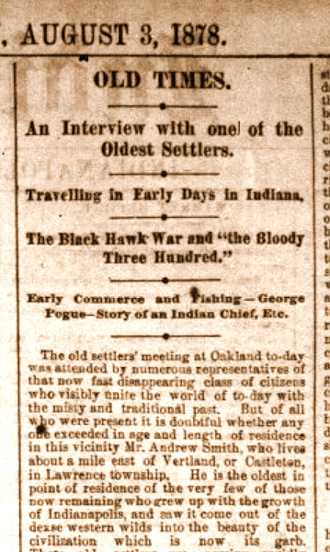
Click image below for full size image
(Transcript Below.)
- Comments (0)
- Trackbacks (0)
RECALLING PIONEER LIFE.

- Friday, December 07 2018 @ 02:27 pm EST
-
- Contributed by:
- Mike
-
- Views:
- 1,435
- Comments (0)
- Trackbacks (0)
Old Oakland Anew!

- Thursday, December 06 2018 @ 01:05 pm EST
-
- Contributed by:
- Mike
-
- Views:
- 1,222
While looking for historical information regarding Old Oakland Golf Course I happened upon the following video that highlights many of the recent improvements made to the grounds. We've seen the heavy equipment there, now we know what they were up to.
Published to YouTube on Jul 16, 2018 by Williams Creek Management
Aerial footage and time elapsed video of Williams Creek Management restoring Old Oakland Golf Course in Indianapolis, IN.
- Comments (0)
- Trackbacks (0)
Real Estate Transfer

- Wednesday, December 05 2018 @ 04:02 pm EST
-
- Contributed by:
- Mike
-
- Views:
- 1,936
- Comments (0)
- Trackbacks (0)
Excitement! Well, A-Plenty

- Wednesday, December 05 2018 @ 03:04 pm EST
-
- Contributed by:
- Mike
-
- Views:
- 781
- Comments (0)
- Trackbacks (0)
AUTO SMASHES BUGGY

- Wednesday, December 05 2018 @ 01:36 pm EST
-
- Contributed by:
- Mike
-
- Views:
- 660
- Comments (0)
- Trackbacks (0)





